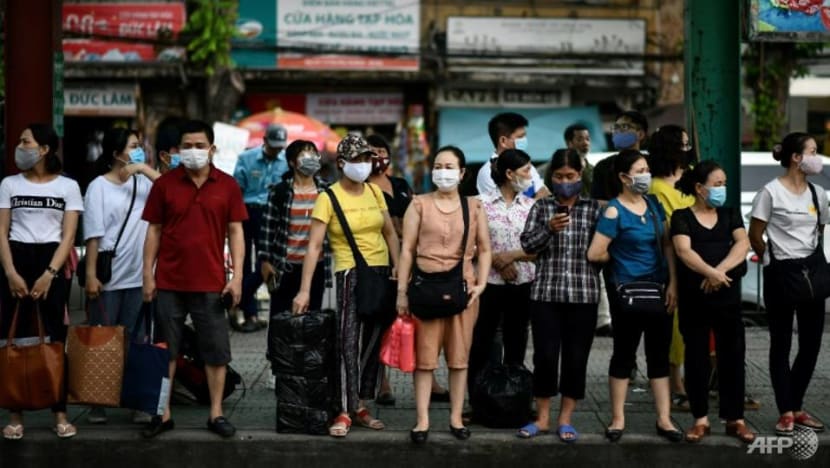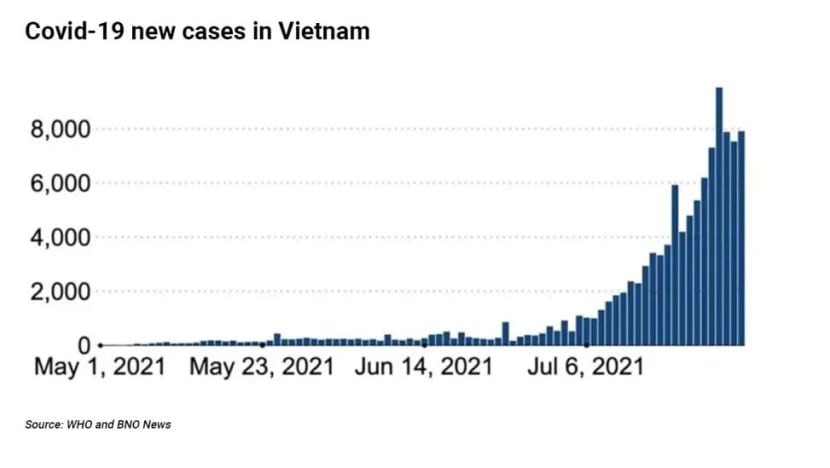Commentary: What's behind Vietnam's first ever COVID-19 wave
With just over 15 per cent of the population having gotten first jabs, Vietnam is at the bottom of the ladder in Southeast Asia in terms of vaccine rollout, say researchers.

SINGAPORE: Vietnam has moved from being an exemplar to a cautionary tale in the ongoing fight against COVID-19.
For almost 18 months since January 2020, residents in the country largely led a relatively normal life with minimal disruptions. With remarkable resilience, the economy grew by an enviable 2.9 per cent in 2020.
But since early May, the country reported a sharp increase in COVID-19 infections. On Aug 19, Vietnam reported 8,880 new cases, with most new infections in Ho Chi Minh City.
In total, Vietnam has confirmed 302,101 cases, with more than 85 per cent of those infected reported in July alone, based on data from Johns Hopkins University. Of Vietnam’s 6,770 deaths, about half were reported in the previous month.
The Delta variant is circulating more virulently in Ho Chi Minh City and the Southern provinces. There are multiple concurrent clusters reported in many provinces, in a variety of settings such as in major cities, in industrial parks, in hospitals, in residential areas and in quarantine sites.
There are still clusters and cases with unknown sources of infection, posing a very high risk of onward community transmission.
At the national level, the government mobilised around 17,000 medical workers to help Ho Chi Minh City tackle this scourge. Healthcare workers, including doctors and nurses (both active and retired), and medical students are joining hands in the latest fight.
Furthermore, Ho Chi Minh City authorities have decided to establish another six COVID-19 field hospitals, providing an additional 17,000 beds.
WHAT’S BEHIND THE RAPID SPREAD
There are several reasons for the rapid spread of COVID-19 in South Vietnam.
One reason is the highly contagious nature of the Delta variant. Based on the chart below, the surge started in July, with daily caseloads hitting above 9,000 at one point.

Most of the infected cases were concentrated in Ho Chi Minh City and nearby Binh Duong Province. This 9,000 figure was again breached twice in August.
Another reason was the slow response of the authorities in Ho Chi Minh City. Although a lockdown was imposed in parts of the city on May 31, the authorities took no additional steps from the entire month of June until Jul 24, when stricter measures were introduced.
This was despite the fact that the number of infected cases in the city started to increase rapidly from Jul 6.
Yet another contributory factor was the lack of strict application of COVID-19 safety measures. Face mask-wearing and social distancing were not strictly adhered to by many residents and not enforced.
(Find out how one Singapore taxi driver deals with the fear of being infected with COVID-19 despite being vaccinated on CNA's Heart of the Matter podcast.)
Testing and tracing became more difficult with the number of infected clusters and cases climbing rapidly. At times, mass testing was not efficient due to the longer time interval between antibody tests and PCR tests.
SLOW VACCINE ROLLOUT
The shortage of vaccines and the slow pace of vaccination compounded the problems. The government only unveiled a vaccine fund of US$1.1 billion in June to secure enough doses to vaccinate 70 per cent of the population – 70 million people – and achieve herd immunity early next year.
However, at the moment, vaccine supplies from Japan, the United Kingdom, the United States and the COVAX facility account for just 15.8 million doses out of the 140 million doses required to vaccinate 70 per cent of the population. More vaccine supply will only arrive from October.
Nanocovax, a homegrown vaccine, is expected to be ready in November. The shortage of vaccines may push the timeline to attain herd immunity to the second quarter of 2022.
In addition, the Delta variant may require the vaccination rate to be higher, at more than 80 per cent of the population. Moreover, carrying out vaccination when COVID-19 is rapidly spreading may not be as effective as antibodies tend to form significantly only a few weeks after receiving the first jabs.
As of Aug 19, just over 15 per cent of the population got the first jabs, putting Vietnam at the bottom of the ladder in Southeast Asia, together with Myanmar.
The current simultaneous lockdown in many provinces has significantly slowed down economic production, dampened market sentiment and severely affected the livelihood of millions of people.
But the highest priority now is to bring the COVID-19 situation under some form of control. With stricter measures in place, stronger enforcement and greater momentum to contain the spread, Vietnam will see a brighter light at the end of the tunnel.
Ha Hoang Hop is a Visiting Senior Fellow of the Vietnam Studies Programme at ISEAS – Yusof Ishak Institute. Lye Liang Fook was previously Senior Fellow at ISEAS – Yusof Ishak Institute. This commentary first appeared on ISEAS – Yusof Ishak Institute’s blog, Fulcrum.














